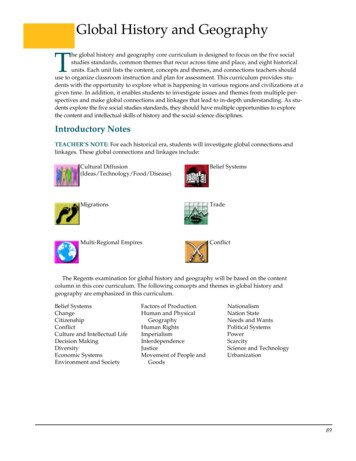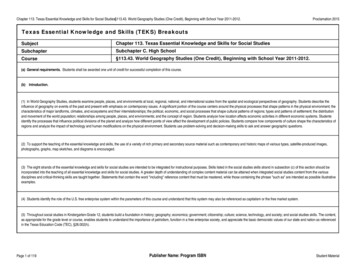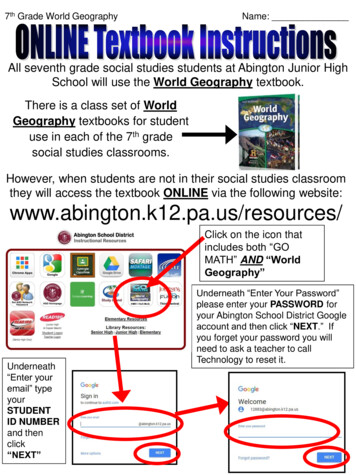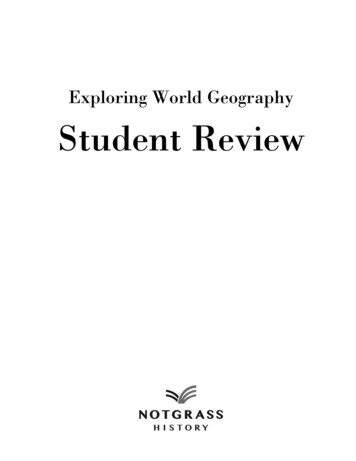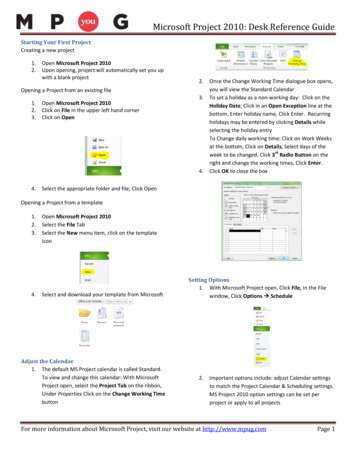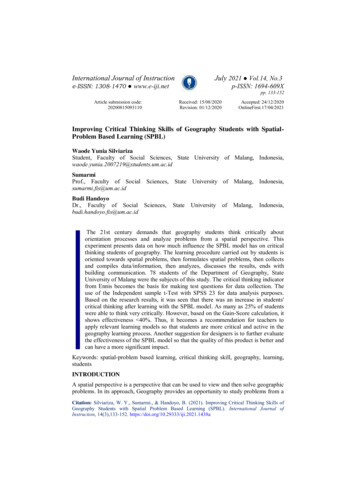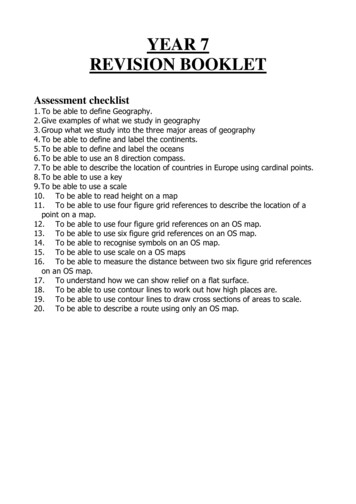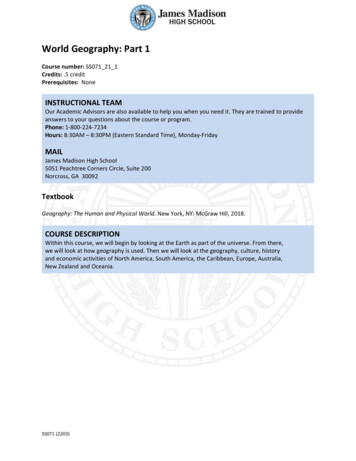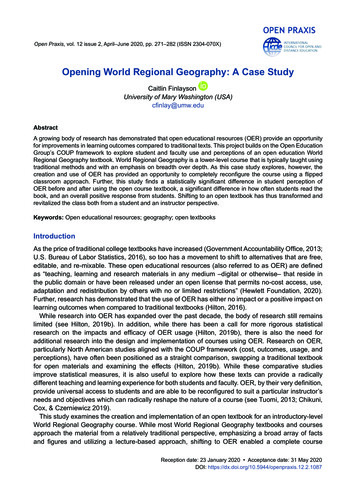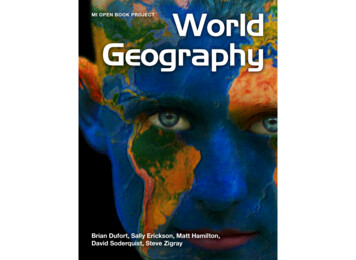
Transcription
WorldGeographyMI OPEN BOOK PROJECTBrian Dufort, Sally Erickson, Matt Hamilton,David Soderquist, Steve Zigray
WorldGeography
The text of this book is licensed under a Creative CommonsNonCommercial-ShareAlike (CC-BY-NC-SA) license as part ofMichigan’s participation in the national #GoOpen movement.This is version 1.4.4 of this resource, released in August 2018.Information on the latest version and updates are available on theproject homepage: on-NonCommercial-ShareAlike CC BY-NC-SAii
The Michigan Open BookProjectAbout the Authors - 6th Grade World GeographyBrian DufortShepherd Public SchoolsOdyssey MS/HSBrian is originally from Midland, MI and is a graduate of Northern Michigan University.He has spent his entire teaching career at Odyssey Middle/High School, an alternativeeducation program in the Shepherd Public School system. In 2001, his environmentalstudies class was one of seven programs from the United States and Canada to bechosen as a winner of the Sea World/Busch Gardens Environmental ExcellenceAward. Brian is also the Northern Conference director of the Michigan Alternative Ath-Project Manager: Dave Johnson,Wexford-Missaukee Intermediate SchoolDistrict6th Grade Team Editor: Amy Salani,Wexford-Missaukee Intermediate SchoolDistrict6th Grade Content Editor: Carol Egbo6th Grade World Geography AuthorsBrian Dufort, Shepherd Public SchoolsSally EricksonLivonia Public SchoolsCooper Upper ElementarySally has taught grades 3-6, as well as special education. She has served asa district literacy leader for many years and participated in the Galileo Leadership Academy in 2001-03. She is proud to be a teacher.Sally Erickson, Livonia Public SchoolsMatt Hamilton, East Jordan PublicSchoolsDavid Soderquist, Three Rivers SchoolsSteve Zigray, Concord Public SchoolsMatt HamiltonEast Jordan Public SchoolsEast Jordan Middle SchoolMatt grew up in Cadillac, MI. He holds a bachelor and masters degree from MichiganState University. He currently teaches middle school History and Geography. Mattstarted and advises a club at his school called the Shoe Club to inspire his students toDream Big. His wife and two daughters enjoy traveling and spending time in the outdoors.
David SoderquistThree Rivers Public SchoolsThree Rivers Middle SchoolFor the Past 11 years David has taught 6-8 grade Social Studies for Three RiversMiddle School. He serves as Department Head, School Improvement Member andSocial Studies Rep for his area. Over the past few years he has completed his Masters Degree in Curriculum and Instruction and become a state recognized Instructional Coach.Steve ZigrayConcord Community SchoolsConcord Middle SchoolSteve Zigray is a 6th grade teacher. He holds a Bachelor’s Degree from Central Michigan University and a Masters Degree in K-12 Administration from Eastern MichiganUniversity. Honors Steve has been awarded are the 2001 Junior Achievement Educator of the Year and he was nominated for Jackson Magazine’s, Educator of the year in2014. He has also coached high school and middle school sports, worked on variousschool improvement committees, wrote the 6th grade Common Assessment tests forJackson County ISD and is an active member in the community as well as the PTO. Helives in southeast Jackson County with his beautiful wife and three fantastic daughters.
Chapter 3LatinAmericaQUESTIONS TO GUIDE INQUIRY1. How are we, as members of a global society,interconnected?2. How do people’s actions impact the world?3. How does the environment affect human behavior andactions?
Section 1Human/Environment Interaction in Latin AmericaIntroductionLatin AmericaQUESTIONS TOGUIDE INQUIRYThe area known as Latin America is1. How are we, asmembers of aglobal society,interconnected?made up of the region south of theUnited States, beginning at the riverthat separates the U.S. from Mexico,the Rio Grande’, and extending to the2. How do people’sactions impactthe world?3. How does theenvironmentaffect humanbehavior andactions?Interactive 3.1 More AboutLatin Americasouthern tip of South America, an areaknown as Cape Horn.This region includes Mexico, CentralAmerica, South America and theImage source: http://en.wikipedia.org/wiki/Latin America#/media/islands of the Caribbean Sea.File:Latin America %28orthographic projection%29.svgThis video created by a teacherfor his class gives an overview ofLatin America and many of thethings you’ll study about in thissection.Latin America is home to 23% of theworld’s forests and 31% of its freshwater. Despite a wealth of resources, theregion’s population growth and the way in which people have used the landaround them, have led to the destruction of many of these resources.As the population continues to grow, a major challenge becomes finding safewater and ways to maintain sanitation in towns and cities. Pollution, both in the airand water (freshwater, oceans, and seas) is also a major problem confronting thepeople of Latin America. In some areas, competition over scarce resources has46
led to social and environmental conflicts. These thenpose a risk to the lifestyles of all who live there.Interactive 3.2 Rain ForestThreatsFor example, when humans dam a river, thereare consequences, both good and bad.If you look back to the second and third questionsthat guide this chapter: “How do people’s actionsYou will study some of these consequencesimpact the world?” and “How does the environmentthroughout this chapter.affect human behavior and actions?” you’ll begin toEnvironment Interaction” means.The theme of Human-Environment interaction is antheme. Humans interact both positively andnegatively with the environment around them.The Theme of “Human-Environment Interaction”discover what the geographic theme of “Human-Latin America is a great place to study thisThis short article from NationalGeographic will give you a littlebackground information on anissue you might choose to studyfurther in this chapter.interesting one to explore because its roots are notjust planted in geography. It runs through all of the social studiesdisciplines. It is a part of history, economics, and civics as well asgeography and the sciences. Here’s an example from earlyInteractive 3.3 InteractiveJournalhistory:Humans have learned over time how to adapt to the environmentaround them and how to modify it to suit their needs. Most earlypermanent settlements sprang up around sources of water. Insome of these places humans began to modify the environmentaround them so that they could settle in large regions aroundwater. An early form of humans interacting with the environmentwas irrigation which allowed water from these major watersources to be brought in to surrounding farms to provide food forpeople.Please note: once you havecreated your own copy of thisdocument, this widget will onlyreturn you to the blank copy. Youwill need to access yours byopening from your own GoogleDocument.47
Section 2Physical Geography - MexicoQUESTIONS TO GUIDE INQUIRYMexico & Central America Mexico and the nations1. How are we, as members of a globalsociety, interconnected?of Central America make up the southern portionInteractive 3.4 GoogleMaps - Mexicoof the North American continent.2. How do people’s actions impact the world?3. How does the environment affect humanbehavior and actions?The Geography of MexicoMexico is bordered by the United States to itsnorth, with the Rio Grande dividing much of thetwo countries. The Gulf of California and thePacific Ocean lie to the west of Mexico,Guatemala and Belize are found toUse this interactive widget tozoom in on and see the physicalcharacteristics of Mexico.the south, and the Gulf of Mexico and the Caribbean lay to its east.Mexico is a land with a wide range of geographical featuresranging from swampy areas and tropical forests to arid desertsand high mountain ranges.Central Mexico is mainly a plateau which has mountain ranges onboth sides. The northern area of the plateau is very arid and makesup nearly 40% of the total area of country. The two main mountainranges found in Mexico are the Sierra Madre Oriental and theSierra Madre Occidental. Volcanoes and smaller mountain rangesImage source: ericaSRTM-CentralLarge-picasa.jpg48
can also be found in southern areasof Mexico. The appearance of theInteractive 3.5Earthquakes in Mexicomany mountains and volcanoes, asWhat characteristic of Mexico’s geography do you think isthe biggest challenge for the people living there? Usewell as earthquakes is due toevidence to support your claim.Mexico’s placement along thewestern edge of the North Americantectonic plate. Actually, Mexico islocated at a place on the earthwhere three different tectonic platescome together. The movement ofthese plates causes a great deal ofFind the most recent data forearthquakes in Mexico using thiswebsite.geographic activity in Mexico.Image source: /World tectonic plate map large.png49
Section 3Physical Geography - Central AmericaQUESTIONS TO GUIDE INQUIRYCentral America1. How are we, as members of a globalsociety, interconnected?Central America is often referred to as its own2. How do people’s actions impact the world?3. How does the environment affect humanbehavior and actions?Interactive 3.6 GoogleMaps - Central Americaregion, but it is actually the southern portion of theNorth American continent. There are sevencountries in this region which you can see on theembedded Google Map: Belize, Costa Rica, ElSalvador, Guatemala, Honduras, Nicaragua,and Panama.Even though Central America is a relativelysmall area, its physical geography is veryUse this interactive widget tozoom in on and see the physicalcharacteristics of Central America.diverse. In some places it is very high, likethe volcanic mountains and highlands.There are also lowlands covered inrainforest and dry savanna areas.Central America contains ruggedUsing the Google Map and themap on this page, describeCentral America’s location inthe world.mountains and diverse amounts ofvegetation. It is located near two oceans - both the Atlantic and thePacific.Image source: /CIA map of Central America.png50
With natural hazards such as volcanic activity, earthquakes, andhurricanes, Central America is the site of many natural disasters.The volcanic activity results in eruptions and earthquakes. Theclose location to the oceans make the area vulnerable tohurricanes. In the past. Hurricanes and the floods that oftenfollow can have a devastating effect on the lowland areas. InDecember of 1998, Hurricane Mitch struck Central Americaleaving thousands dead and even more homeless.How do natural disasters often result in people inour global society becoming interconnected?Image source: /Sierra Madre Occidental.jpgThe major landform in Central America is the Sierra Madremountain range. These rugged mountains extend through thecenter of Central America, running from Mexico in the westthrough the center of the region. Some of these mountains riseas high as 14,000 feet, with the highest being found inGuatemala. On each side of these highlands are coastal lowlandsthat run along the Atlantic and Pacific coasts. The lowlands aregenerally hot and humid, while the highlands are cool andrelatively dry. There is also an active belt of volcanic mountainswhich runs along the Pacific coast from Mexico all the way downto Costa Rica.51
Section 4Physical Geography - South AmericaSouth AmericaQUESTIONS TOGUIDE INQUIRYInteractive 3.7 GoogleMaps - South AmericaSouth America is the1. How are we, asmembers of aglobal society,interconnected?fourth-largest continent inthe world. It can bedivided into three2. How do people’sactions impactthe world?physical regions:3. How does theenvironmentaffect humanbehavior andactions?plains. Because of themountains/highlands,river basins, and coastalvariety of geographicUse this interactive widget tozoom in on and see the physicalcharacteristics of South America.features on this continent,there are a large number of biomes, regions of the worldwith similar climate, animals and plants, found here.The deserts of the coastal plains rise up to meet themountains of the Andes. The river basin of the Amazonhas a dense, tropical rain forest, while the basin ofanother major river, the Prana, is made up of Grassland.With this great variety, there is a large number of plantand animal species, making South America stand outImage source: /South America laea relief location map.jpg52
among the other continents of the world.Mountains & HighlandsHighlands are also a major feature of South America. TheAltiplano (“high plain”) of Peru and Bolivia stands out at anelevation of about 12,300 feet. Marked by cold, windy weather,The major mountain system in South America is the Andesfew trees survive here. The dominant vegetation is simply grassMountains, with a length of about 5,500 miles, which makes it theand shrubs. The northern area receives enough rainfall to growworld’s longest mountain range. The Andes sit on the westerncrops, whereas the southern half receives relatively little rainfall.side of the continent and stretch from its southern tip to itsnorthern coast. The highest mountain peak in the Andes isAconcagua, which is 22,841 feet tall, making Aconcagua thetallest mountain outside Asia.Image source: http://commons.wikimedia.org/wiki/File:Romanceor Altiplano 1.jpgImage source: :Andes 70.30345W 42.99203S.jpg53
The southern portion of South America is known as Patagonia.River BasinsThis region of Argentina and Chile consists of lower-elevationplateaus and rugged glaciers. The Argentine side features aridsteppes, grasslands and deserts, while the western side found inChile has glaciers in the mountains and even rainforests.Image source: /Amazon rainforest.jpgSouth America has three major river basins: the Amazon,Image source: Patagonia http://en.wikipedia.org/wiki/Santa Cruz Province, Argentina#/media/File:Landschaft von Patagonien.jpgOrinoco, and the Paraná. The Amazon River basin covers nearly 3million square miles, making it the largest watershed in the world.It is also the world’s second longest river, stretching nearly 4,000miles.It begins in the norther part of South America and includessmaller river tributaries that come from the glaciers of the Andes.The Amazon River is the heart of the Amazon rain forest, which isthe world’s largest tropical rainforest and makes up about half of54
the total rainforests found in the world . It covers about 40% ofSouth America and is spread over nine different countries.The Amazon Rainforest is invaluable to the health of the planet asInvestigation: Head to Google to investigate some of the plants thatmake their home in the Amazon and find ways people have used theseplants.it provides about 20% of the world’s oxygen and absorbs anequal amount of carbon dioxide.Interactive 3.8 The WorldWildlife Fund - AmazonRainforestNowhere else on Earth is therethe same kind of diversity ofanimal life like there is in theAmazon Rainforest. There aremore than 2 million species ofinsects, a large variety of animalsthat include many differentprimates, and thousands ofnative birds such as macaws,Learn even more about theAmazon, including some of thethreats at this website from WWF.parrots and toucans.55Image source: /
The Paraná River basin is not as large as the Amazon, but is over1 million square miles. It covers much of southeastern Brazil aswell as Bolivia, Paraguay, and northern Argentina. The ParanáRiver basin supplies water to the large plains found in thesouthern portion of South America, known as the Pampas. ThePampas have rich, fertile soil and predictable rainfall patterns.This makes the area important for ranching and farming.Coastal PlainsThe coastal plains of South America are found on thenortheastern coast of Brazil on the Atlantic Ocean, and the PacificOcean coast of Peru and Chile in the west. The coastal plains arevery dry, with the Brazilian Highlands blocking the sea windsfrom the Atlantic, and the Andes Mountains blocking out themoisture coming in from the Pacific. The Atacama Desert is partThe Orinoco River originates in the highlands of northern Brazilof the coastal plain in the west. It is considered the driest desertand empties into the Atlantic Ocean in Venezuela. The basinregion in the world, receiving less than a half inch of rainfall acovers an area of about 366,000 square miles. There is a vastyear. While the Atacama has few plants and animals found in thegrassland region (savanna) known as the Llanos that is found inregion, it is a main source of copper which is important to thethis area. The Llanos is a great habitat for many bird species, aseconomywell as many different aquatic river species like the piranha,of Chile.Do you think people live in the Atacama Desert? Why orelectric eel, and the crocodile.why not?Image source: /Birds eye view of the Chajnantor plateau in Chile's Atacama Desert.jpg56
Section 5Physical Geography - The CaribbeanQUESTIONS TO GUIDE INQUIRYThe Caribbean1. How are we, as members of a globalsociety, interconnected?The Caribbean Sea is home to over 7,0002. How do people’s actions impact the world?3. How does the environment affect humanbehavior and actions?islands, thirteen of which are independentInteractive 3.9 GoogleMaps - The Caribbeannations. This area is very diverse in terms of itsphysical geography. Many of these islands areprimarily the result of volcanic activity. There arehowever few active volcanoes today. One wellknown volcano that has been active recently isMt. Soufriere of Montserrat. After 365 years oflying dormant, it erupted in 1995 and has beenthe site of on-going volcanic activity ever since.Use this interactive widget tozoom in on and see the physicalcharacteristics of the Caribbean.Various other islands of theCaribbean are known toexperience various forms ofvolcanic activity, even the island ofTrinidad has small volcanoes. Mostof the non-volcanic island found inthis area are coral islands thatformed from the coral reefs foundthroughout the Caribbean.Image source: /CIA map of the Caribbean.pngImage source: /57Soufriere Hills Volcano.jpg
Hills & MountainsWith most of the main islands of the Caribbean being volcanicislands, many are very hilly and mountainous. The largestmountain ranges in the Caribbean include the Northern Range ofTrinidad and the Blue Mountains of Jamaica. Many of theseranges in the Caribbean are covered by rainforests and providean extensive variety of vegetation and wildlife. Because of themountainous and hilly nature found in the lands of the Caribbean,many islands have little to no flat land leading up to thesemountainous areas. This results in the formation of swampswhere runoff rainwater is collected. Trinidad is home to two majorswamps, the Nariva and the Caroni.Rainforests & DesertRainforests are commonly found in South America, but they arealso found on some of the islands of the Caribbean such asJamaica and Puerto Rico. Rainforests add to the diversity of theflora and fauna of these islands. In contrast to these lush areas, anumber of islands are also found to be very arid, almost desertlike. Some of these islands include Aruba, Bonaire, Curacao andGrand Turk. Even though these islands are surrounded by waterthey receive relatively little, or sporadic, rainfall. Islands such asthese have areas that are very rugged and dry. The plant life onthese islands ofteninclude scrubvegetation, and evencactus.Due to the dryclimate, cactus canbe found in manyareas on Aruba.Arikok National Park, ArubaImage source: http://en.wikipedia.org/wiki/Arikok National Park#/media/Photo credit: Brian DufortFile:Arikok NP.jpg58
Section 6History - Early CivilizationsQUESTIONS TO GUIDE INQUIRYSo far a great deal of attention has been paid to the1. How are we, as members of a globalsociety, interconnected?Physical Geography of the region. As you go through2. How do people’s actions impact the world?3. How does the environment affect humanbehavior and actions?the next few sections of this text dealing with history,Interactive 3.10 InteractiveJournalthink about how humans interacted with theirenvironment.Early CivilizationsThe cultivation of crops in the Americas first begannear present-day Mexico City around 5000 B.C.E.Originally these crops were an addition to the huntingand gathering that was done by these early people.By 3000 B.C.E. these people began to rely moreheavily on agriculture. This development spread tothe other hunter-gatherers societies found in southPlease note: once you havecreated your own copy of thisdocument, this widget will onlyreturn you to the blank copy. Youwill need to access yours byopening from your own GoogleDocument.America.How are humans interacting with the environment when practicing agriculture?59
Many important early civilizations developed in this area,flourished around the time of the ancient Greek civilizations andincluding the Olmecs, Zapotecs, Teotihuacanos, Mayas andthe Trojan War. The rise of the Olmecs marked the beginnings ofAztecs. These cultures developed complex societies, achievedcivilization in Central America. Centuries later the oldesthigh levels of technological advancement, developed complexcivilization in South America developed in what would becomearchitecture, and shared many cultural aspects.Peru.These ancient civilizations would rise and fall, eventually beingreplaced by the three great civilizations of Latin America: theMaya, the Aztecs and the Inca.The MayaInteractive 3.11 Pyramidsin MesoamericaThe Mayan civilization was at itsheight from approximately 250 C.E.until 700 C.E. The Mayan civilizationdeveloped a written language,understood advanced mathematicsand had an extensive knowledge ofMap of Mesoamerica, showing locations of cities and historical sites Image source: /meso/images/3.jpgastronomy. They even developed acalendar based on theirFollow this link to view aslideshow of the pyramids ofMesoamerica:With the establishment of agriculture, groups of early Americansastronomical observations. Thebegan to develop more advanced societies. The earliestMayans were also very skilledcivilization in the Americas first developed along the coast of thearchitects, building large stone pyramids and well developedGulf of Mexico around 1200 B.C.E. This was the Olmeclarge cities.civilization which flourished around the time of the ancient Greekcivilization and the Trojan War. They were a civilization that60
Mayan Calendarit was most likely a combination of these events. Although thecivilization collapsed, the Mayan people still can be found livingsouthern Mexico and into Central America.Interactive 3.12 The Fall ofthe MayansPart of the Mayan Long Count Calendar included dates written out as five hieroglyphs separated by fourperiods. Photo credit: LiveScienceFollow this link to read a NationalGeographic article about differentpossible reasons for the fall of theMayan civilization. Which one doyou think is correct? Recordwhich theory you believe, andwhy, in your Interactive Journal.Starting around the year 700 C.E., the Mayan empire began toexperience a decline . Archeologists are not sure why thishappened, although some theories as to why include epidemics,earthquakes, drought, and warfare. Many researchers believethat61
The AztecsThe Aztecs appeared inMesoamerica sometime in theearly 13th century. Before then,Interactive 3.13TenochtitlanIn what ways did the Aztecs interact with the environment?a group of people known as theToltecs dominated the area. TheThe IncaAztecs arrived as the Toltecs’The Inca Empire began small, as a group that lived in a village ininfluence was on the decline.the Andes Mountains. When there was an attempt by anotherPerhaps the Aztecs weretribe to conquer them around the year 1200 C.E., the Inca weresomewhat to blame for thisdecline. They built their capitalcity near Lake Texcoco in whatLearn more about Tenochtitlan atthis academic website.today is central Mexico. The Aztecs drained the swampy landsurrounding the lake and built artificial islands in the lake onwhich they established the beginnings of their capital city. Thiscity, established in 1325 C.E., is known as Tenochtitlán. The cityhad around 200,000 inhabitants at one point, making it the thirdlargest city in the world at that time.The Aztecs developed a complex system of agriculture, whichincluded irrigation practices, to support their civilization. Cropsgrown by the Aztecs included corn, beans, squash, and potatoes.They also built a powerful military. These two developmentsallowed them to conquer other native peoples around them,spread their influence, and build a strong empire.able to fight off their attackers and emerge victorious. From thattime on, it would be the Inca that looked to expand their territoryand grow an empire. Over the next 100 years, the Inca conqueredmany different tribes throughoutSouth America. The Inca EmpireInteractive 3.14 The Incawould grow to stretch nearly theentire length of the western side ofSouth America, becoming one ofthe largest empires in the world.The Inca had a well-developedcivilization. They built a strongcentral government, and had anequally strong army. They builtroads, bridges and aqueducts tocarry water to their cities. The IncasWatch this video (requires internetconnection) for an explanation ofhow the Inca built their empire.What examples of humanenvironment interaction do yousee?also kept official records with a62
device called the quipu, which means knot. This was a cordbeans and peanuts. The potato was especially important as itwhich had a series of smaller colored strings attached to it oncould easily grow in the poor mountain soil and survive the coldwhich knots were tied. As no South American culture had anytemperatures.system of writing at this time, this record keeping system was amajor development for the Inca and allowed them to save andsend information in a much easier and reliable manner thansimple word of mouth.The Inca also developed terrace farming in order to adapt to thesharp mountain slopes and make farming possible in themountains. The Inca were so organized that they had stockpilesof food that could be distributed to the people when times ofdrought occurred and crops failed. Many of the foods we eattoday were developed and grown by the Inca, such as; potatoes,Image source: /Machu Picchu, Peru.jpgWith their well-developed society, strongmilitary, agricultural practices and engineeringInteractive 3.15Interactive Journalaccomplishments, the Inca continued to growin power and influence. The Inca maintainedtheir dominance in South America until theSpanish conquistadors arrived and defeatedthem in 1533.Return to your interactive journal. Describeways ancient civlizations adapted to andchanged their environment?Image source: /Pisac006.jpgPlease note: once youhave created your owncopy of this document,this widget will onlyreturn you to the blankcopy. You will need toaccess yours byopening from your own63Google Document.
Section 7CultureQUESTIONS TO GUIDE INQUIRYLatin America is home to about 525 million people who live in 33 different1. How are we, as members of a globalsociety, interconnected?countries. The region’s population includes Native Americans, Europeans,2. How do people’s actions impact the world?3. How does the environment affect humanbehavior and actions?Africans, Asians, and mixtures of these groups. It is a unique blending of culturesthat has been influenced by both the native population and by the establishmentof colonies by the European nations of Spain and Portugal. Marriages betweenEuropean colonists and native populations established what is called the Mestizoclass. Mestizos are people with a mix of both indigenous and European ancestry.Today, mestizos make up a large portion of the population of South America.Another factor influencing the cultural landscape of South America was theimportation of enslaved Africans. Most of these Africans were brought to Brazil,and it is their cultural practices, mixed with native and European beliefs thatcreated a unique cultural landscape that can be seen in cultural traits such asmusic, dance and foods. Religion remains the backbone of many South Americancultures. While Catholicism, the official religion of both Spain and Portugal at thetime of colonization, dominates the continent, there are other spiritual beliefs thathave had an influence on other social activities.The Day of the Dead Festival, or Dia de los Muertos, is a Mexican festivalcelebrating the reunion of dead relatives with their families. This festival occurseach year on November 1st (All Saints Day) and 2nd (All Souls Day). The origins ofthe festival come from the ancient native peoples who believed that the souls of64
the dead return each year to visit with their living relatives, andto eat, drink and be merry. With the arrival of the Spanish,certain Christian beliefs were brought into the festival. Today’spractice calls for all of the deceased children to be rememberedon November 1st, All Saints Day with toys and colorful balloonsadorning their graves. The next day, All Souls Day, adults whohave died are honored with displays of their favorite food anddrinks, as well as ornaments and personal belongings. Flowersand candles are placed on the graves and are supposed toguide the s
World Geography Brian Dufort, Sally Erickson, Matt Hamilton, David Soderquist, Steve Zigray MI OPEN BOOK PROJECT. World Geography . This is version 1.4.4 of this resource, released in August 2018. Informati
